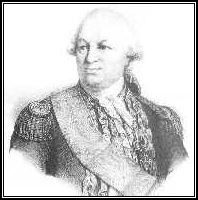 In April 1782, the American Revolution was virtually over. Benjamin Franklin was in Paris about to
begin the peace talks. In Fort Royal, Martinique,the French Admiral, The Compte, Francois Joseph Paul de Grasse,
had gathered his battle fleet and was preparing to join with the Spanish for an invasion of British-held Jamaica.
In April 1782, the American Revolution was virtually over. Benjamin Franklin was in Paris about to
begin the peace talks. In Fort Royal, Martinique,the French Admiral, The Compte, Francois Joseph Paul de Grasse,
had gathered his battle fleet and was preparing to join with the Spanish for an invasion of British-held Jamaica.
Seven months previously, in September 1781, de Grasse had landed French reinforcements for General
Washington's troops in Virginia and then trounced the British fleet under Admiral Graves in the Battle of the Capes.
This sealed the defeat of the British and insured the success of the American Revolution. De Grasse had become
a popular hero in America.
De Grasse's French ships left the Virginia coast on November 4, 1781 and set sail for the Caribbean. The French,
riding a wave of victory, were determined to oust the British from all of the new world and win the Caribbean for
the glory of France. By January 1782, de Grasse's fleet began capturing British possessions and within three months
the only islands remaining under British rule were Jamaica, St. Lucia, Antigua and Barbados.
On April 8, 1782, de Grasse departed Martinique with his entire fleet of 33 ships-of-the-line headed for a
rendezvous with 12 Spanish ships-of-line and 15,000 troops for an attack on the British colony in Jamaica. Also with
him was a convoy of over 100 cargo ships filled with goods and products bound for the French homeland. Prior to joining
with the Spanish war ships, the convoy was to take off on its own for France.
 While de Grasse was preparing his fleet at Fort Royal,
British Admiral Sir George Brydges Rodney arrived in the Caribbean from England and immediately
took overall command of the British Caribbean forces which now had a total strength of 36 ships-of-the-line.
While de Grasse was preparing his fleet at Fort Royal,
British Admiral Sir George Brydges Rodney arrived in the Caribbean from England and immediately
took overall command of the British Caribbean forces which now had a total strength of 36 ships-of-the-line.
De Grasse's intentions were no mystery to the British. From the heights of Pigeon Island at St. Lucia and through
reports by his scouting frigates, Rodney kept watch on the French fleet and when he learned of it's departure,
he set off in pursuit. Within a couple of days, the British fleet had caught up with the French and both admirals
prepared for battle.
On April 12, the two fleets engaged at close broadside range on parallel opposite courses near Les Iles des Saintes,
a group of small islands near Guadeloupe. As the lead French ships approached the British rearmost ships,
de Grasse signaled his fleet to reverse course so that the action could continue on parallel courses, but the
command was not carried out by all of his ships' captains.
The disobeyed order to reverse course together with a sudden change in the wind caused gaps in the French battle line.
Seizing this opportunity, Admiral Rodney then executed a maneuver never before seen in a major naval battle.
He turned his ships ninety degrees and sailed through the broken French line of battle, splitting the French line
into four segments. In doing this, the guns on each side of the British ships were brought to bear on the French
with little risk of return fire.
De Grasse could not reform his battle line and as the day went on, six heavily damaged French ships hauled down their flags.
Finally, Ville de Paris, de Grasse's 130-gun flagship, struck her colors and de Grasse surrendered his ship and his
sword to the British Captain, Lord Cranston. Of the Ville de Paris' crew, over 400 had been killed and more than 700
were wounded. Overall, the French were soundly beaten. The invasion fleet was decimated. The French ships were
either sunk or captured and more than 6,000 men perished.
The British treated de Grasse more as an honored guest than a prisoner of war. He was shipped to England where
King George III returned his sword to him and allowed him to return to France as a paroled prisoner of war.
In France, a courts martial convicted many of de Grasse's subordinate officers for disobeying orders, but he himself
was not tried. However, many held him responsible for the defeat and he became a public scapegoat. He died in 1788 at the age of 66.
Admiral Rodney brought the captured ships to Jamaica and the grateful colonists erected a marble statue in his honor.
The statue now stands in Kingston's Spanish Town Square. The British Government made Rodney a peer.
The Battle of the Saintes, firmly established Britain as the dominant sea force entering the Nineteenth Century
and the coming Napoleonic Wars. The successful tactic employed by Rodney became known as "Crossing the Tee".
The Battle of Surigao Strait, history's last and final Battleship-to-Battleship engagement,
in October 1944, was won by the U.S. Navy employing this very same tactic.
|

